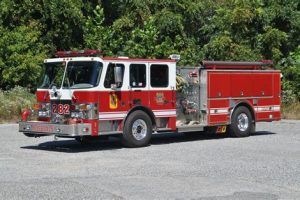Table of Contents
Learn how to start a volunteer fire department in Texas with our comprehensive guide. Discover the necessary steps, requirements, and legal considerations to establish a successful community-based firefighting organization. Find out how to recruit volunteers, secure funding, obtain equipment, and navigate the administrative process. Equip yourself with the knowledge and resources to contribute to public safety and protect your local community.
Are you passionate about serving your community and making a difference in the lives of others? Have you ever considered starting a volunteer fire department? Well, if you’re in Texas, we’ve got good news for you. In this booming state filled with friendly faces and a strong sense of camaraderie, there’s always a need for dedicated individuals to protect their communities from the wrath of fire. But where do you start? How do you navigate through the complex process of establishing a volunteer fire department? Fear not, because we’ve got you covered. In this guide, we’ll walk you through the essential steps and provide valuable insights on how to kickstart your own volunteer fire department in the great Lone Star State.
Introduction
Starting a volunteer fire department in Texas can be a rewarding experience for individuals who are passionate about serving their community and ensuring the safety of their fellow residents. Volunteer fire departments play a crucial role in providing emergency services in areas where professional fire departments may not be readily available. This article will guide you through the process of starting a volunteer fire department in Texas, from understanding the requirements to recruiting dedicated volunteers.
Research and Planning
Before embarking on the journey of starting a volunteer fire department, it is important to conduct thorough research and planning. Begin by identifying the specific area in Texas where there is a need for a volunteer fire department. Assess the current emergency services available and determine if there are any gaps that your department can fill. This step is crucial in gaining support from the community and local authorities.
Form a Nonprofit Organization
In order to legally operate as a volunteer fire department, you will need to establish a nonprofit organization. Consult with an attorney experienced in nonprofit law to understand the legal requirements and assist with the formation process. This step includes drafting bylaws, filing necessary paperwork, and obtaining tax-exempt status from the Internal Revenue Service (IRS).
Recruit Volunteers
A successful volunteer fire department relies on dedicated individuals who are willing to commit their time and effort to serve the community. Reach out to local residents, businesses, schools, and community organizations to spread the word about your volunteer fire department and recruit interested individuals. Hosting information sessions and attending local events can also help generate interest and attract potential volunteers.
Training and Certifications
It is crucial for all volunteer firefighters to undergo proper training and obtain the necessary certifications to ensure their effectiveness and safety. Collaborate with local fire academies, professional fire departments, or the Texas Commission on Fire Protection (TCFP) to provide training opportunities for your volunteers. This will include courses on firefighting techniques, emergency medical services, hazardous materials response, and more.
Secure Funding
Running a volunteer fire department requires financial resources to cover operational costs, equipment purchases, and training expenses. Explore various funding sources such as grants, fundraising events, community donations, and local government support. Establish relationships with local businesses and organizations that may be willing to sponsor your department or provide in-kind donations.
Equipment and Facilities
Acquiring the necessary equipment and facilities is essential for a functional and efficient volunteer fire department. Research the specific requirements set by the Texas State Fire Marshal’s Office (SFMO) and other regulatory bodies. Ensure that you have the appropriate fire apparatus, protective gear, communication systems, and a suitable facility to house your equipment and serve as a base of operations.
Establish Mutual Aid Agreements
Collaboration with neighboring fire departments through mutual aid agreements is vital for volunteer fire departments to effectively respond to emergencies. Reach out to nearby fire departments and establish partnerships that allow for resource sharing, joint training, and coordinated responses. Mutual aid agreements ensure that your department has access to additional resources when faced with larger incidents or multiple concurrent emergencies.
Community Outreach and Education
A volunteer fire department should actively engage with the community it serves. Conduct regular outreach programs to educate residents on fire safety, disaster preparedness, and emergency response procedures. Participate in community events, offer CPR and first aid training, and provide smoke alarm installations to help prevent emergencies and enhance overall community safety.
Establish Standard Operating Procedures
Developing a set of standard operating procedures (SOPs) is crucial for maintaining consistency and ensuring the effectiveness of your volunteer fire department’s operations. SOPs should cover various aspects, including incident response protocols, equipment maintenance, training requirements, and administrative procedures. Regularly review and update these procedures to adapt to changing circumstances and best practices.
Conclusion
Starting a volunteer fire department in Texas requires careful planning, dedication, and community support. By following the steps outlined in this article, you can lay the foundation for a successful volunteer fire department that serves the needs of your community. Remember, the commitment and passion of your volunteers will be the driving force behind your department’s success in protecting lives and property from potential fire hazards.
How To Start a Volunteer Fire Department in Texas
A Comprehensive Guide to Establishing Your Own Fire Department in the Lone Star State
Starting a volunteer fire department in Texas requires careful planning and coordination to ensure the safety and well-being of local communities. This guide aims to provide a step-by-step approach, highlighting the necessary considerations and procedures involved in setting up a volunteer fire department in Texas.
1. Conducting a Comprehensive Needs Assessment:
Before embarking on establishing a volunteer fire department, it is crucial to conduct a thorough needs assessment to determine the specific requirements of the local community. This involves studying demographic data, analyzing response times, and evaluating existing fire protection services in the area. By identifying the gaps in service coverage, you can tailor the department’s provisions to adequately address community needs.
2. Forming an Organizing Committee and Drafting Bylaws:
Assembling an organizing committee will facilitate the initial planning and execution process. The committee should include dedicated individuals with diverse skills, such as firefighters, business administrators, and community leaders. Together, they can develop the department’s bylaws, outlining its structure, operational guidelines, and the roles and responsibilities of members.
3. Securing Necessary Funding:
Establishing a volunteer fire department requires securing funding to cover essential expenses. While funding sources may vary, options to consider include applying for state grants, seeking local donations or corporate sponsorships, holding fundraisers, or seeking support from utility companies, as they often contribute toward firefighting operations in their service areas.
4. Acquiring Equipment and Firefighting Apparatus:
An adequate supply of equipment and firefighting apparatus is essential for a volunteer fire department. This includes fire engines, ambulances, communication devices, personal protective equipment, and various firefighting tools. Partnering with neighboring departments or seeking assistance from national firefighting organizations can help in acquiring necessary equipment at affordable costs.
5. Training and Certifying Firefighters:
Training and certifying firefighters is crucial for maintaining an efficient and competent fire department. Collaborating with Texas A&M Forest Service, state-certified training institutions, or local fire academies can offer training programs to volunteers, ensuring they have the necessary skills and knowledge to respond effectively to emergencies.
6. Forming Mutual Aid Agreements:
Collaboration with neighboring departments through mutual aid agreements establishes a cooperative relationship for responding to larger incidents or shortages in resources. Developing these agreements ensures adequate backup support and strengthens the overall emergency response capabilities of your volunteer fire department.
7. Meeting Legal and Administrative Requirements:
Ensure compliance with the legal and administrative requirements to establish and operate a fire department in Texas. This includes obtaining necessary permits, licenses, and insurance coverage, as well as registering with state authorities and adhering to reporting and auditing obligations.
8. Establishing a Community Outreach Program:
Developing a community outreach program is crucial for building trust, establishing a positive reputation, and generating local support for your volunteer fire department. Engage with community members through initiatives like fire prevention education, CPR training, hosting open-house events, and participating in local festivals and parades.
Conclusion:
Starting a volunteer fire department in Texas requires careful planning, organization, and community involvement. By following the steps outlined in this guide, you can lay a solid foundation for establishing a successful volunteer fire department that serves and protects your local community. Remember, dedication, collaboration, and ongoing commitment are essential for ensuring the safety and well-being of Texas residents.
How to Start a Volunteer Fire Department in Texas: A Comprehensive Guide
As the saying goes, When disaster strikes, heroes rise. Nowhere is this more evident than in the dedicated men and women who volunteer their time and efforts to protect their communities as firefighters. In the vast state of Texas, where tight-knit communities abound, establishing a volunteer fire department can be a vital step towards ensuring the safety and well-being of residents. This comprehensive guide aims to provide a step-by-step approach to starting a volunteer fire department in Texas, outlining the essential aspects that need to be considered.
1. Assess Community Needs:
- Evaluate the population size and density of your community, determining whether there is a sufficient need for a volunteer fire department.
- Research existing fire departments in neighboring areas to ensure that there are no overlaps or gaps in coverage.
- Engage with community members through public meetings or surveys to gauge their interest and support for a volunteer fire department.
2. Establish a Core Group:
- Recruit committed individuals passionate about firefighting and community service to form the core group of your volunteer fire department.
- Ensure that the group possesses a diverse range of skills, including firefighting experience, administrative expertise, and leadership qualities.
- Assign roles and responsibilities within the core group, such as chief officer, treasurer, secretary, and training coordinator.
3. Develop a Business Plan:
- Create a comprehensive business plan outlining the objectives, strategies, and financial considerations of your volunteer fire department.
- Identify potential sources of funding, such as grants, community donations, or fundraising events.
- Consider the costs associated with equipment, training, insurance, and maintenance.
4. Seek Legal and Organizational Support:
- Research and comply with all legal requirements for establishing a volunteer fire department in Texas, including incorporating as a nonprofit organization.
- Consult with local authorities, city officials, and county representatives to gain their support and guidance throughout the process.
- Establish partnerships with neighboring fire departments, fostering collaboration and mutual aid agreements.
5. Training and Certification:
- Ensure that all members of your volunteer fire department receive proper training and certification in firefighting techniques, emergency medical services, and other relevant skills.
- Partner with established training academies or seek assistance from nearby fire departments to provide quality training programs.
- Maintain regular training sessions and drills to keep members updated on the latest techniques and procedures.
6. Acquire Equipment and Resources:
- Compile a list of essential firefighting equipment, including fire trucks, personal protective gear, communication systems, and medical supplies.
- Seek funding through grants, donations, or local government support to acquire the necessary equipment.
- Establish relationships with suppliers and manufacturers to ensure ongoing access to reliable and up-to-date equipment.
7. Publicize and Recruit Volunteers:
- Launch a public awareness campaign to inform the community about the establishment of the volunteer fire department.
- Utilize various communication channels, such as local newspapers, social media platforms, and community events, to spread the word.
- Recruit dedicated volunteers through open houses, informational sessions, and direct outreach efforts.
8. Establish Standard Operating Procedures:
- Create a set of standard operating procedures (SOPs) outlining protocols for responding to emergencies, conducting drills, maintaining equipment, and ensuring member safety.
- Regularly review and update the SOPs to incorporate lessons learned and industry best practices.
- Train all members on the SOPs to ensure consistency and effective operations.
9. Foster Community Engagement:
- Participate in community events, parades, and public gatherings to showcase the volunteer fire department’s presence and build trust within the community.
- Establish community outreach programs, such as fire safety education initiatives or CPR training sessions.
- Regularly communicate with community members through newsletters, social media updates, and town hall meetings.
10. Evaluate and Adapt:
- Regularly assess the effectiveness and efficiency of your volunteer fire department’s operations.
- Solicit feedback from community members, volunteers, and partner organizations to identify areas for improvement.
- Adapt and evolve your strategies and procedures to meet the changing needs and challenges of your community.
By following these steps and maintaining a strong sense of dedication, Texas residents can successfully establish a volunteer fire department that serves as a critical lifeline during emergencies. Remember, the journey may be challenging, but the impact on your community will be immeasurable.
Thank you for joining us today as we explored the process of starting a volunteer fire department in the great state of Texas. We hope that this article has provided you with valuable insights and guidance on how to embark on this noble endeavor. Starting a volunteer fire department requires dedication, passion, and a strong sense of community, and we commend you for taking the first step towards making a difference in your local area.
First and foremost, it is crucial to emphasize the importance of conducting thorough research and familiarizing yourself with the legal requirements and regulations governing volunteer fire departments in Texas. This includes understanding the necessary qualifications, certifications, and training programs that volunteers must complete. By adhering to these regulations, you will ensure that your department operates efficiently and in compliance with the law.
Next, building a strong foundation for your volunteer fire department involves garnering support from the community. This can be achieved through effective communication and outreach efforts. Engage with local businesses, community organizations, and individuals who may be interested in volunteering or providing financial assistance. Hosting informational meetings, participating in community events, and utilizing social media platforms are all effective ways to raise awareness about your cause and attract potential volunteers and donors.
Lastly, it is essential to prioritize ongoing training and education for your volunteer firefighters. Providing regular training sessions, workshops, and exercises will ensure that your team remains well-prepared to handle various emergency situations. Additionally, fostering a culture of camaraderie and teamwork within your department will not only enhance the effectiveness of your operations but also create a supportive and motivating environment for your volunteers.
In conclusion, starting a volunteer fire department in Texas requires careful planning, community involvement, and a commitment to continuous improvement. By following the steps outlined in this article, you are on your way to making a positive impact and safeguarding the well-being of your local community. We wish you the best of luck in your journey and thank you once again for joining us today!
.
People also ask: How to start a volunteer fire department in Texas?
When considering starting a volunteer fire department in Texas, several questions may arise. Here are the most common inquiries about this topic:
- 1. What are the requirements to start a volunteer fire department in Texas?
- Having a designated service area that is not already covered by an existing fire department
- Gaining approval from the local governing body or county commissioners
- Forming a nonprofit organization or association
- Acquiring the necessary firefighting equipment and vehicles
- Recruiting and training volunteer firefighters
- 2. How can I obtain funding for a volunteer fire department?
- Applying for grants specifically aimed at supporting fire departments
- Seeking donations from local businesses and community members
- Organizing fundraising events such as car washes, bake sales, or community dinners
- Participating in regional or state-level funding programs for emergency services
- Collaborating with neighboring fire departments for shared resources and funding opportunities
- 3. Are there any training requirements for volunteer firefighters in Texas?
- 4. How can I recruit volunteer firefighters for my department?
- Advertise through local newspapers, social media, and community bulletin boards
- Hold informational meetings or open houses to explain the benefits and requirements of volunteering
- Collaborate with schools, colleges, and civic organizations to spread the word
- Offer training opportunities and incentives such as tuition assistance or recognition programs
- Establish a mentorship program to support new recruits and foster a sense of camaraderie
Establishing a volunteer fire department in Texas requires fulfilling certain criteria. These typically include:
Funding for a volunteer fire department can come from various sources, including:
Yes, volunteer firefighters in Texas must undergo specific training to ensure their preparedness and effectiveness. The Texas Commission on Fire Protection (TCFP) sets the training standards, which typically include courses on fire behavior, suppression techniques, emergency medical services, and hazardous materials handling.
To attract individuals interested in becoming volunteer firefighters, you can:
Starting a volunteer fire department in Texas requires careful planning, dedication, and collaboration with local authorities and the community. By meeting the necessary requirements, securing funding, providing adequate training, and recruiting passionate individuals, you can establish a valuable and life-saving service within your area.






